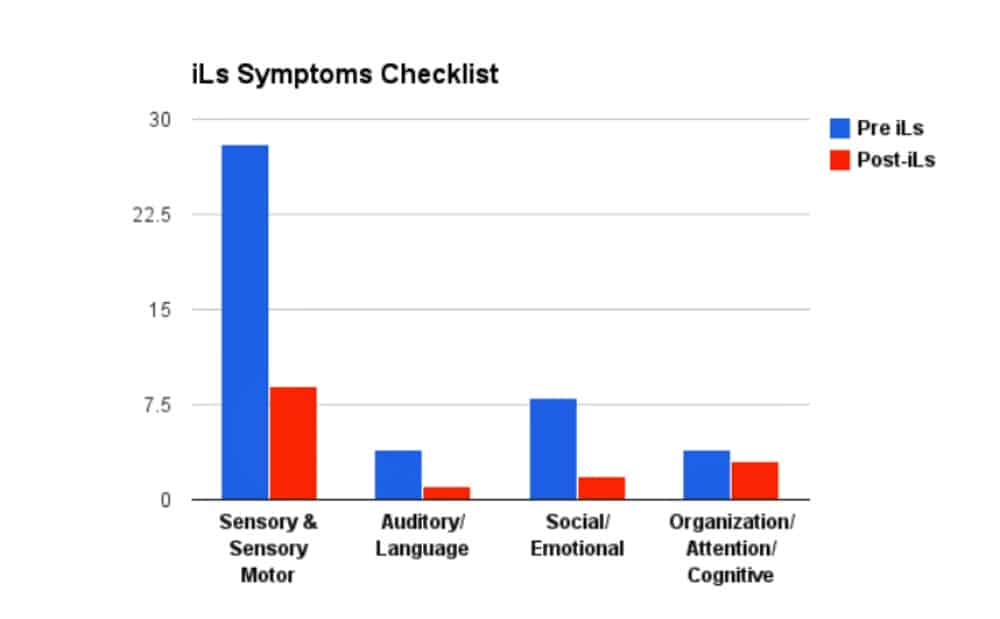Symptoms
“K” is a 12-year-old boy with attention, motor and social difficulties who presented with deficits in attention, coordination, social communication, and emotional regulation. His parents described concerns in his ability to verbalize his thoughts, to independently complete work and manage his emotions. They also observed motor tics and poor gross motor coordination.
K’s second grade teacher referred him for testing related to difficulties in the classroom. A Psycho Educational Evaluation revealed moderately atypical range for behavioral inattention and recommended that he be observed for further evidence of attention deficit disorder. At that time, an individual education plan was implemented which provided accommodations such as repeated directions, redirecting attention, and preferential seating. Later, he was diagnosed with ADHD and Asperger’s syndrome. He was prescribed medication for the ADHD.
Intervention
The iLs Program was completed as a home program with in-clinic treatments every other week. The iLs Concentration and Attention Program was 5 months.
After three consecutive years of using stimulant medications to control the symptoms of attention deficit disorder, K’s parents are relieved to no longer rely on medication; K is making honor roll with A’s and B’s. K’s parents also report progress in multiple areas, including his ability to complete school work without their assistance, confidence in expressing ideas in conversation, overall control of his body and greater participation in school.
The Results
The iLs Symptoms Checklist was used to assess the changes in symptoms before beginning and after completion of the iLs Program.

A lower score indicates a reduction in symptoms, i.e. improvement.
The significant changes in the iLs Checklist scores translated to his improved performance in school, ability to interact with classmates and participate in extracurricular activities. In six months’ time, K had improved 2 years in manual dexterity, one year and 3 months in bilateral coordination, and 6 years in balance. It was noted that K’s upper extremity score declined significantly. The upper limb coordination subset is comprised of 7 tests in which the child catches, throws, and dribbles a tennis ball. At the initial testing, K scored a perfect score of 39 raw points whereas at the reassessment date, K missed 6 points decreasing his raw score to 32 points resulting in decreases his standard score. Follow-up testing will be completed to further validate K’s motor performance abilities.
Parental observations and comments:
- “K had previously attended social skills training and had made good improvements. Although there was still room for progress, we were not focused on his social skills when we began iLs training. Now, we notice that K has more confidence. We can tell when he gives his opinions and how well he participates in conversations. He speaks openly without the anxiety of wondering what people are thinking about him. We were pleasantly surprised to see those improvements!”
- “When we began the program, K was very unbalanced. He was awkward with his arms when he walked and ran. Now, when he gets out of the car and is walking away to school, I can tell a difference in his walking. He has more control of his body and you can tell his overall coordination is better.”
- “Last year he did not want to join clubs, but this year he brought the Beta Club form to me wanting to join. The school personnel have noticed that he has increased his participation in academics and extracurricular activities. I talked with the physical education teacher the other day, who said K was doing wonderfully in PE class.”
“I was very scared to take him off medication because I did not want his grades to drop. Nonetheless, we decided to take him off the medication and try iLs. It worked perfectly. He still has the same grades!”
Overall, K demonstrates significant changes in many areas. In the area of social/emotional functioning, K has significant improvements in his socialization, often initiating participation in conversation and adding new ideas and opinions.
Per the parent report, K is able to “balance school stress,” demonstrating decreased feelings of frustration and more emotional control. Now K is independently completing homework tasks in an efficient manner whereas last school year he required significant parent involvement. K says he has increased ability to recall ideas while working, which results in faster work completion.
During the past three years of school, K required stimulant medications to remediate his decreased attention, impulsivity, and motor tics. When K began the medications, his parents noticed a decrease in the frequency of his motor tics. Currently, though he is not taking any medication, his motor tics have almost completely disappeared. This year, K has received all As and Bs and made Honor Roll.
Learn More
Learn how iLs addresses coordination, social communication, attention and emotional regulation.



 © 2025 Unyte Health US Inc.
© 2025 Unyte Health US Inc.